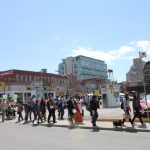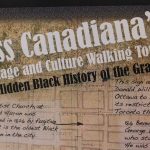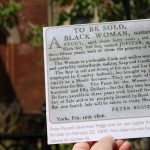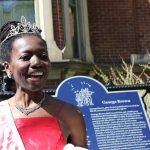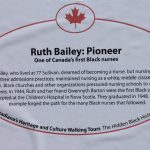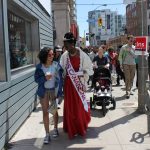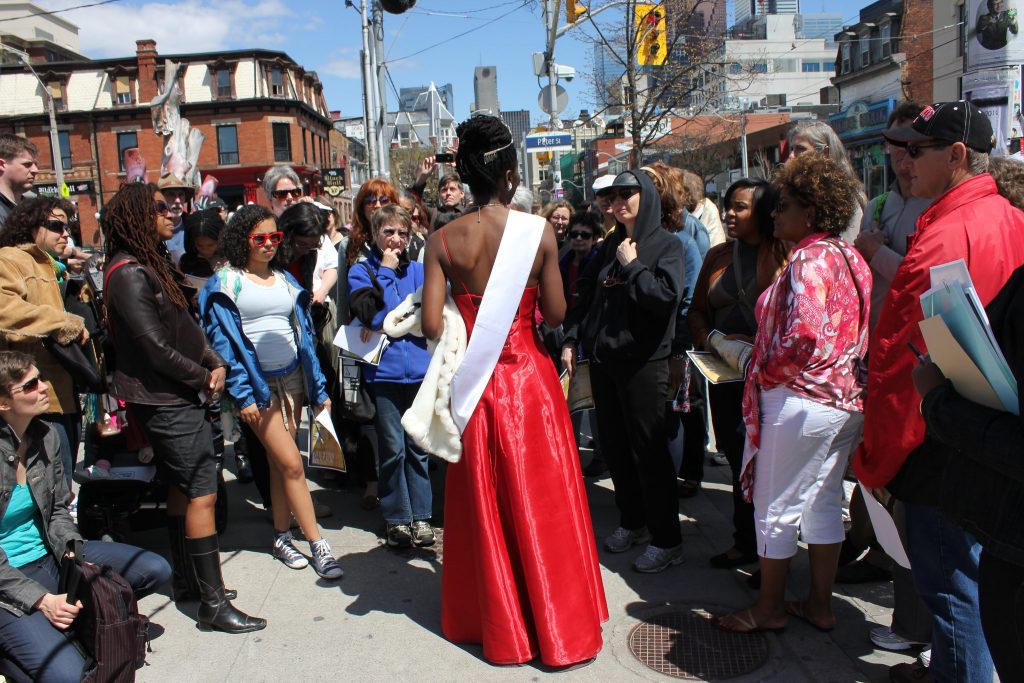
Camille Turner, “Miss Canadiana Heritage and Culture Walking Tour” (2011)
[credit]
“In Miss Canadiana Heritage and Culture Walking Tour, Miss Canadiana acts as a tour guide to the hidden Black histories of Toronto’s Grange neighbourhood. You can View the photo Album here”
- Camille Turner, “Miss Canadiana Heritage and Culture Walking Tour” (2011)
- Camille Turner, “Miss Canadiana Heritage and Culture Walking Tour” (2011)
- Camille Turner, “Miss Canadiana Heritage and Culture Walking Tour” (2011)
- Camille Turner, “Miss Canadiana Heritage and Culture Walking Tour” (2011)
- Camille Turner, “Miss Canadiana Heritage and Culture Walking Tour” (2011)
- Camille Turner, “Miss Canadiana Heritage and Culture Walking Tour” (2011)
““For me, walks really bring awareness to the places that we’re in in a completely different way than any other types of artwork that I’ve seen,” says Toronto artist Camille Turner. “It really makes people see the space in a completely different way, and I think that’s really powerful.”
Turner would know—after creating her soundwalk Hush Harbour, which guides participants on a walk near King and Front Streets in Toronto to reimagine the city’s Black past and to remap Blackness onto the urban landscape, Turner conducted an online survey to get feedback on the piece.
“[The Hush Harbour participants] said they were looking in a new way at the space they walked through every day,” says Turner. “So that way of transforming space is something that walks really do well.”
Currently, Turner is working at one of the formal limits of walking-based art—trying to transform the mobile Hush Harbour walk experience into an installation for the Theatre Centre in Toronto.
“There are limitations to walks as well,” Turner notes, “because people have to come to the place where the walk is made to experience it. I’m trying to uncouple that, so it can be experienced in other places, and travel.”
Turner’s understanding of the power of walking to transform experiences of place started well outside of the art realm.
“I’ve probably gone on lots of different walks, and not necessarily ones that are done by artists,” Turner says, saying one of her favorites was “an amazing walk with Ed Mirvish and Sam the Record Man around Kensington Market” in the 1980s.
Perhaps it is the impact of such experiences that drives Turner to imagine how to make the remapping of space and reclaiming of place available via live, in-person walks, and transform that into something downloadable and reproducible.
For example, Turner has proposed that this year she create a digital version of one of the first art walks she ever did: her Miss Canadiana Heritage and Culture Walking Tour.
Originally performed live in 2011, the piece has Turner, in her Miss Canadiana persona, act as tour guide to hidden Black histories of Toronto’s Grange neighbourhood. (The area is home to the Art Gallery of Ontario and OCAD University, among other canon-building institutions.)
“I am going to do it as a Google Doc so people can actually do it as a self-guided walking tour,” says Turner, who will also remount the work live once more in November 2017.
There may also be a digital or downloadable sound component of the new version of this walk. Turner herself is a great admirer of sonic-walk pioneers like New York’s soundwalk.com, which has created a 9/11 memorial walk with Paul Auster, among other pieces.
“I also really love the sonic walks, because for me, it’s like time travel—you can bring people backward and forward in time,” Turner says. “I use binaural microphones that I put in my ears, so [the recording is] picking up space exactly as I hear it.”
And it’s not just sound technology that is surfacing in Turner’s recent work—in Freedom Tours, a recent collaboration with Cheryl L’Hirondelle for LandMarks2017, Turner organized boat tours around the Thousand Islands area to provide a different kind of mobile storytelling experience. (Turner and L’Hirondelle are also working together on a walk for June 24 in Rouge National Park near Toronto as part of LandMarks2017.)
Ultimately, it is the ability to intervene in history that draws Turner to walking in her practice—especially when it comes to surfacing Black and African experience in spaces constructed by the canon, and by society at large, to read as white or European. (Meetings of past and present Black history also come to the fore in some of Turner’s works in other media, like the combination of contemporary photo-portraiture and historical “runaway slave” notice texts in her series Wanted, co-created with Camal Pirbhai and opening in “Every. Now. Then.” at the Art Gallery of Ontario on June 28.)
“Walking can be an intervention into history—it’s a way of practicing public history, and in bypassing the institutions that create history, you can be a producer of history,” says Turner. “I really like these kinds of ways of working, of intervening in space and in the way that power is kind of written itself in the land.” [credit]
